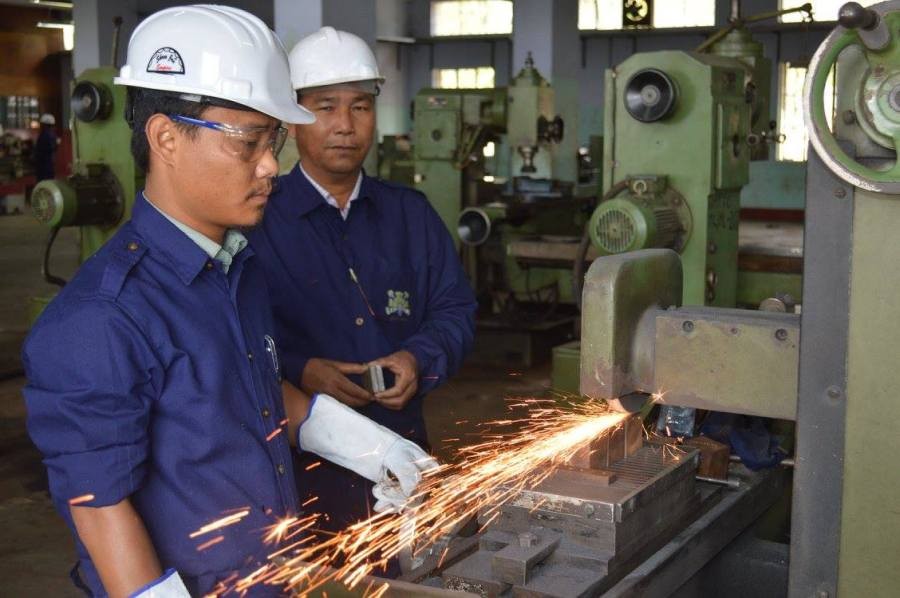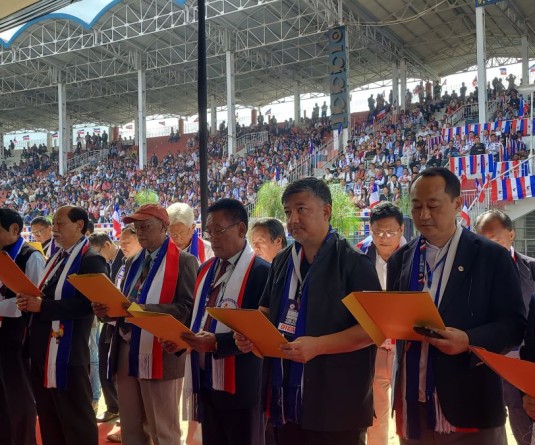A file photo of trainers hands on Surface Grinding Machine at the Nagaland Tool Room and Training Centre (NTTC) in Dimapur. (Photo Courtesy: NTTC Dimapur)

State industrial policy to be revised
Our Correspondent
Kohima | August 28
The Nagaland Sustainable Development Goals (SDGs) Vision 2030 in its Goal-9 on “Industry, Innovation and Infrastructure” aims to build resilient infrastructure, promote inclusive and sustainable industrialization and foster innovation.
The vision is to develop quality and reliable infrastructure across the state to provide an enabling economic environment for the promotion of inclusive and sustainable industrialization that fosters innovation.
2030 targets includes; make air transport accessible to all, establish around 500 start-ups recognized under start-up Nagaland, establish 11 Mini Industrial Growth Centres and 5 Border Trade Centres, all Government to Citizen (G2C) services shall be electronically/IT enabled and broadband optical fibre connectivity to every village in the state
Challenges
The vision statement stated that a robust transport network is the backbone for all development, especially in the context of Nagaland to develop its industry and infrastructure at large. Various strategies will be undertaken across the state.
Road transport
The focus is on providing standardized and efficient passenger bus services within the state as well as inter-state services to Assam, Arunachal Pradesh, Manipur, Tripura and Myanmar for strengthening socio-economic relations with neighboring states and countries.
Infrastructure
Nagaland State Transports department has come up with the acquisition of fleet, conversion of existing state buildings to commercial complexes and construction of inter-state bus and truck terminals. Infrastructure development has been planned in a similar manner in the eastern districts of Longleng, Mon, Kiphire and Tuensang/Pangsha/Pungro for improvement of trans-border road transport connectivity.
Airways
The state helicopter services are operated on a weekly basis connecting major district headquarters and evacuation of patients from remote areas. The aim is to establish helipads in all districts and sub-divisional headquarters including tourist spots along with airstrips for landing of small aircrafts at technical feasibility locations as well as spots for gliders.
The development of Greenfield Airport is in consonance with the national policy of having an airport in every state capital to mainland.
The Nagaland government has acquired an area of land measuring 1013.72b acres capable of 4.4 KM runway for operation of A-320 Airbus. The proposed airport will serve both ends of civil and military needs as the state being located at strategic point of National Security.
Besides, the only existing Dimapur Airport is 74 km away from the state capital and due to winding roads, it takes 2 hours to cover the distance. The proposed airport at Ciethu will have an advantage short distance of 21 Km which could be covered in less than an hour.
Keeping in mind the ever increasing demand of air transport, feeder small airstrips in all the district will be pursued to make air transport accessible to all by 2025.
Railways
In pursuit of multimodal connectivity, the plan is to connect Kohima with the rest of the country by a broad gauge railway line by 2020.
Coupled with this, the foothills of Nagaland are to be connected with a railway network from Tizit to Dimapur to allow for greater and easier movement of goods and services.
To enhance international connectivity in the railway sector, which must supplement the road network, government will propose to build a railway line from Dhansiripar in Dimapur district to Karong in Manipur which would logically connect to Moreh and touch lines with the network in Myanmar, thereby creating the possibility of concretizing the Trans-Asian Railway line by 2025.
Waterways
The Doyang, Tizu, Dikhu and Dhansiri rivers has been identified by the Inland Water Transport Authority of India for cheaper means of transport as well as water sports.
Net Connectivity
Internet/Intranet connectivity to all government institutions including educational institutions and all Government to Citizen (G2C) service shall be electronically/IT enabled, and broadband optical fibre cable connectivity to every village in the state.
Promote Micro, Small and Medium Enterprises
Judicious dedication of resources to priorities and adapting the goals and targets in accordance with local challenges, capacities and resources available is important. A two–pronged approach is to be adopted with two broad focus areas.
The first entails horizontal interventions which would give stimulus to a wider spectrum of industries and sectors. The second entails vertical interventions which would focus on sector or industry specific direct and indirect incentives linked to measurable parameters.
The key to achieving the development goal would however ride on the availability of finance and the effective management of the financial resources.
Strengthen industrialization process
The vision statement stated that the existing industries would be strengthened to make them more productive and competitive by infusion of capital investments for technology upgradations/expansions coupled with provisions of marketing incentives/subsidies as applicable.
It stated that industrial zones to be identified and the development and strengthening of the basic infrastructure such as roads and other connectivity, improvement of power, water and other amenities and infrastructure required to promote industrialization shall be taken up on priority in these areas.
Identification of potential industries and sectors considering the market, raw material, technology, skill and other competitive advantages from the state is key.
Focus shall be on identification and promotion of enterprise with import substitution products having domestic market potentialities and enterprises offering maximum spin-off in terms of primary and tertiary units whereby equitable distribution of income and employment is moderated.
A High Powered Industrial Facilitation Committee to be constituted to provide an overall direction and monitor the progress and implementation of the SDG schemes and initiatives.
The State Industrial Policy shall be revised to make it competent and conducive to resolving the challenges of promoting and development of sustainable industrialization of the state.
There will be focus on facilitation of special incentives in core sectors that can provide the impetus for growth and sustainability of enterprise. Gender equity shall be a provision applicable across the spectrum of the policy implementation.
Establishment/upgradation of institutions to encourage, promote and develop sector specific skills and requirements and construction/strengthening of industrialization friendly financial institutions for focused financial interventions.
Enacting coherent statute for encouragement of investment in the state inter-alia facilitating Ease of Doing Business to be a priority to the government and state agencies promoting industrialization in the state, the vision statement added.
Current status of Nagaland
• The total road length achieved considering all categories of roads is 14, 377.15 km with a density of 86.74/100sq km against the national density is 142.70/100 sq.km
• The entire state is well connected by roads but the poor conditions of these roads are affecting the economic development of the state.
• The state government has launched the Nagaland Start-up Policy 2019 which aims to establish Nagaland as a model start-up leader in the North- East region.






